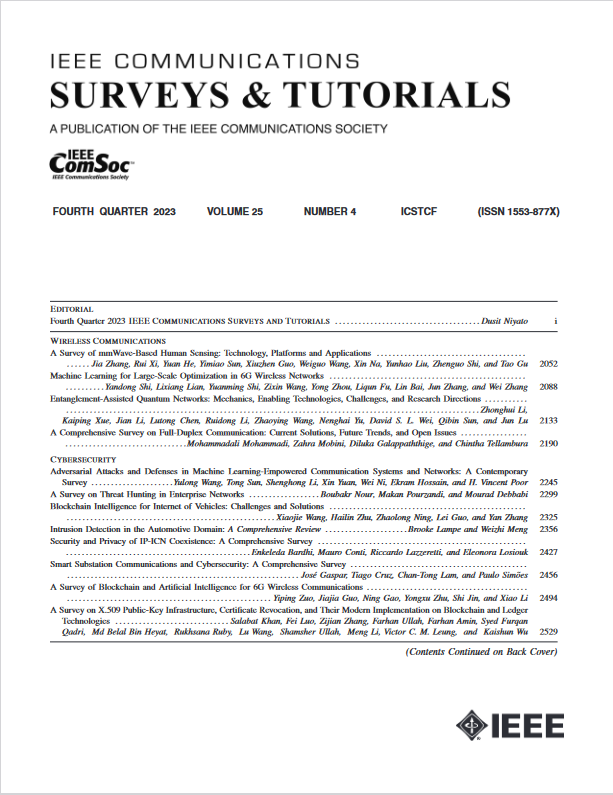When Crowdsensing Meets Smart Cities: A Comprehensive Survey and New Perspectives
IF 34.4
1区 计算机科学
Q1 COMPUTER SCIENCE, INFORMATION SYSTEMS
引用次数: 0
Abstract
Crowdsensing has received widespread attention in recent years. It is extensively employed in smart cities and intelligent transportation systems. This paper comprehensively surveys the latest research advancements in crowdsensing for smart cities from a novel perspective. Specifically, this paper is categorized according to sensing entities in smart cities, including human-oriented sensing, vehicle-oriented sensing, and infrastructure-oriented sensing. Meanwhile, the development of Unmanned Aerial Vehicle (UAV)-assisted sensing in recent years is also summarized, accompanied by a timeline of related research. To facilitate easy comprehension, we have positioned the reading flow into the corresponding architectures, resolved problems, existing technical solutions, and specific application scenarios for different sensing entities. In particular, the problems to be solved are further analyzed from four technical perspectives, namely mathematics and operational research, artificial intelligence and machine learning, incentive mechanisms, security and privacy protection. Based on the proposed taxonomy, recent studies are thoroughly investigated to illustrate the current state of research in crowdsensing. Furthermore, this paper highlights the emerging applications of human-oriented and vehicle-oriented sensing in smart cities, as well as the frameworks, platforms, simulators, and datasets involved in crowdsensing. Finally, this paper discusses research directions related to crowdsensing in smart cities, such as digital twins, metaverses, and artificial intelligence-generated content. The primary goal of this survey is to review and synthesize prior research, identify potential avenues for future research, and explore opportunities for collaboration with other relevant research domains.当群体感应遇上智慧城市:全面调查与新视角
近年来,众测受到了广泛关注。它被广泛应用于智慧城市和智能交通系统。本文从全新的视角全面综述了智慧城市众感的最新研究进展。具体而言,本文根据智慧城市中的传感实体进行了分类,包括以人为本的传感、以车辆为本的传感和以基础设施为本的传感。同时,对近年来无人机辅助传感技术的发展进行了总结,并给出了相关研究的时间轴。为了便于理解,我们将读取流程定位到相应的架构中,解决问题,现有技术解决方案,以及针对不同传感实体的具体应用场景。特别是从数学与运筹学、人工智能与机器学习、激励机制、安全与隐私保护四个技术角度进一步分析需要解决的问题。在此基础上,对最近的研究进行了深入的研究,以说明群体感知的研究现状。此外,本文重点介绍了以人为本和以车辆为本的传感在智慧城市中的新兴应用,以及涉及众传感的框架、平台、模拟器和数据集。最后,本文讨论了智慧城市众感的相关研究方向,如数字孪生、元生态、人工智能生成内容等。本调查的主要目的是回顾和综合先前的研究,确定未来研究的潜在途径,并探索与其他相关研究领域合作的机会。
本文章由计算机程序翻译,如有差异,请以英文原文为准。
求助全文
约1分钟内获得全文
求助全文
来源期刊

IEEE Communications Surveys and Tutorials
COMPUTER SCIENCE, INFORMATION SYSTEMS-TELECOMMUNICATIONS
CiteScore
80.20
自引率
2.50%
发文量
84
审稿时长
6 months
期刊介绍:
IEEE Communications Surveys & Tutorials is an online journal published by the IEEE Communications Society for tutorials and surveys covering all aspects of the communications field. Telecommunications technology is progressing at a rapid pace, and the IEEE Communications Society is committed to providing researchers and other professionals the information and tools to stay abreast. IEEE Communications Surveys and Tutorials focuses on integrating and adding understanding to the existing literature on communications, putting results in context. Whether searching for in-depth information about a familiar area or an introduction into a new area, IEEE Communications Surveys & Tutorials aims to be the premier source of peer-reviewed, comprehensive tutorials and surveys, and pointers to further sources. IEEE Communications Surveys & Tutorials publishes only articles exclusively written for IEEE Communications Surveys & Tutorials and go through a rigorous review process before their publication in the quarterly issues.
A tutorial article in the IEEE Communications Surveys & Tutorials should be designed to help the reader to become familiar with and learn something specific about a chosen topic. In contrast, the term survey, as applied here, is defined to mean a survey of the literature. A survey article in IEEE Communications Surveys & Tutorials should provide a comprehensive review of developments in a selected area, covering its development from its inception to its current state and beyond, and illustrating its development through liberal citations from the literature. Both tutorials and surveys should be tutorial in nature and should be written in a style comprehensible to readers outside the specialty of the article.
 求助内容:
求助内容: 应助结果提醒方式:
应助结果提醒方式:


